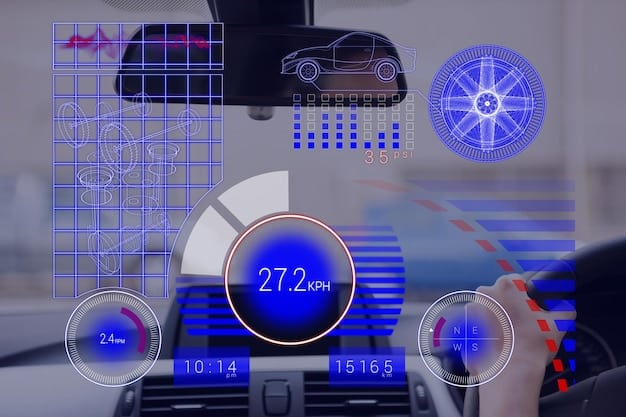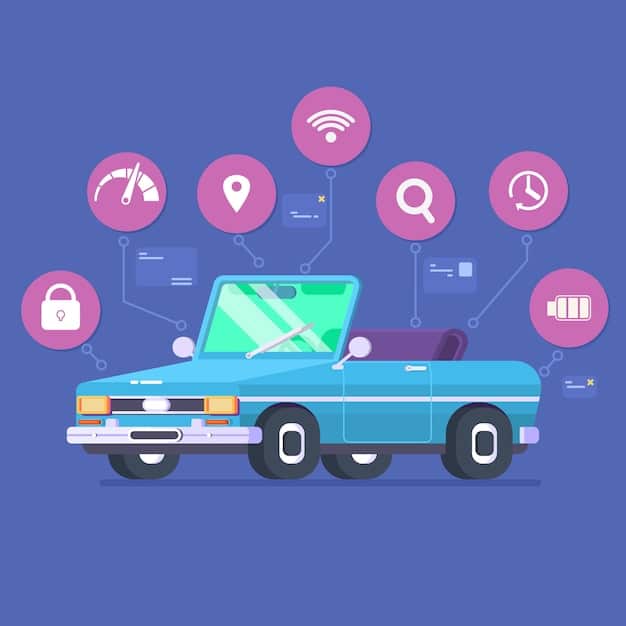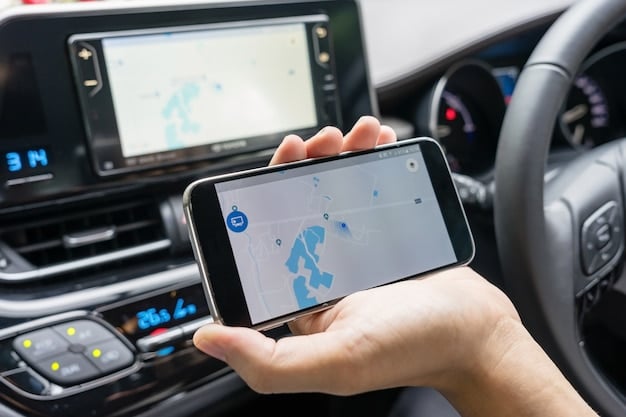Emerging Trends in Automotive Software and Connectivity in the US Market

Emerging trends in automotive software and connectivity in the US market include the rise of software-defined vehicles, enhanced cybersecurity measures, and the integration of advanced driver-assistance systems (ADAS) with cloud services for improved safety and performance.
The automotive industry is undergoing a monumental shift, driven by rapid advancements in software and connectivity. The US market, a key player in this transformation, is witnessing the emergence of groundbreaking trends that are reshaping the very core of vehicles. Let’s explore the emerging trends in automotive software and connectivity in the US market, uncovering what’s driving these changes and what they mean for the future of mobility.
The Rise of Software-Defined Vehicles (SDVs)
Software-Defined Vehicles (SDVs) are becoming a dominant force in the automotive landscape. These vehicles are characterized by their heavy reliance on software for core functions, moving away from traditional hardware-centric designs. This trend promises increased flexibility, over-the-air (OTA) updates, and personalized driving experiences.
What Defines a Software-Defined Vehicle?
SDVs are essentially computers on wheels, where software controls a significant portion of the vehicle’s functions. This includes everything from the powertrain and chassis to infotainment and advanced driver-assistance systems (ADAS).
Benefits of Software-Defined Architecture
The software-defined architecture offers several advantages, including:
- Enhanced Flexibility: Software can be easily updated and modified to add new features or improve performance without requiring hardware changes.
- Over-the-Air (OTA) Updates: OTA updates allow manufacturers to remotely update vehicle software, fixing bugs, improving features, and even adding new functionalities.
- Personalized Driving Experiences: Software enables customization of vehicle settings and features to suit individual driver preferences.
SDVs are revolutionizing how vehicles are designed, manufactured, and maintained. They represent a significant departure from traditional automotive engineering, paving the way for more innovative and adaptable vehicles.

Enhanced Cybersecurity Measures for Connected Cars
As cars become increasingly connected, with more and more software integration, the risk of cyberattacks increases. Protecting connected cars from malicious actors is a paramount concern for automakers and consumers alike. Enhanced cybersecurity measures are now an essential trend in automotive software development.
The Growing Threat Landscape
Connected cars are vulnerable to a variety of cyber threats, including hacking, data breaches, and malware infections. These attacks can compromise vehicle safety, privacy, and functionality.
Key Cybersecurity Strategies
To mitigate these risks, automakers are implementing a range of cybersecurity strategies, such as:
- Robust Encryption: Encryption technologies are used to protect sensitive data transmitted between the vehicle and external networks.
- Intrusion Detection Systems: These systems monitor vehicle networks for suspicious activity and alert drivers or authorities in case of a potential attack.
- Secure Boot Processes: Secure boot processes ensure that only authorized software can be loaded onto the vehicle’s systems.
- Regular Security Audits: Automakers conduct regular security audits to identify and address vulnerabilities in their systems.
Cybersecurity is no longer an afterthought but a fundamental aspect of automotive software development. Robust cybersecurity measures are crucial for maintaining the safety and trust of connected cars.
Integration of ADAS with Cloud Services
Advanced Driver-Assistance Systems (ADAS) are becoming increasingly sophisticated, relying on data from various sensors and cameras to enhance safety and convenience. The integration of ADAS with cloud services is enabling new levels of functionality and performance.
How Cloud Connectivity Enhances ADAS
Cloud connectivity allows ADAS to access real-time data, such as traffic conditions, weather forecasts, and road hazards. This data can be used to improve the accuracy and effectiveness of ADAS features, such as adaptive cruise control, lane-keeping assist, and automatic emergency braking.
Benefits of Cloud-Connected ADAS
The integration of ADAS with cloud services offers several benefits, including:
- Improved Situational Awareness: Real-time data from the cloud enhances the vehicle’s awareness of its surroundings, enabling more informed and proactive driving decisions.
- Enhanced Safety: By leveraging cloud data, ADAS can anticipate potential hazards and take appropriate action to prevent accidents.
- Over-the-Air Updates: Cloud connectivity enables OTA updates for ADAS software, ensuring that the systems are always up-to-date with the latest features and improvements.
The integration of ADAS with cloud services is revolutionizing the way we drive, making vehicles safer, more efficient, and more convenient to operate.
Advancements in In-Vehicle Infotainment Systems
In-vehicle infotainment systems are evolving beyond simple entertainment. Modern systems offer a seamless blend of navigation, communication, and entertainment, enhancing the overall driving experience. These advancements are a significant trend in automotive software and connectivity.
The Evolution of Infotainment
Modern infotainment systems are transforming with high-resolution displays, intuitive interfaces, and seamless smartphone integration. Voice control, gesture recognition, and augmented reality are additional features enhancing their usability and functionality.
Key Features of Modern Infotainment Systems
Today’s infotainment systems include:
- High-Resolution Displays: Providing crisp and clear visuals for navigation, media, and vehicle information.
- Seamless Smartphone Integration: Allowing drivers to access their favorite apps and services directly from the vehicle’s display.
- Voice Control: Enabling hands-free control of various vehicle functions, such as navigation, music, and phone calls.

Advancements in in-vehicle infotainment systems are making driving more enjoyable and convenient. These systems offer a wide range of features that cater to the needs and preferences of today’s drivers.
The Role of 5G in Automotive Connectivity
5G technology is poised to revolutionize automotive connectivity, offering faster speeds, lower latency, and increased bandwidth. This will enable new applications and services, transforming the driving experience. 5G connectivity is rapidly emerging as a critical component of the future of automotive technology.
Benefits of 5G Connectivity
5G offers significantly faster data speeds and lower latency than previous generations of wireless technology. This enables a wide range of new applications, including:
- Enhanced ADAS: Faster data transfer rates and lower latency enable more responsive and accurate ADAS features.
- Real-Time Traffic Updates: 5G enables real-time traffic updates, helping drivers avoid congestion and optimize their routes.
- Seamless Entertainment Streaming: Passengers can enjoy seamless streaming of high-definition video and audio content.
Next generation vehicle connectivity relies heavily on the continued rollout and adoption of 5G networks. The enhancements that 5G brings are critical unlocks for automakers.
Data Analytics and Predictive Maintenance
Data analytics is playing an increasingly important role in the automotive industry, enabling automakers to gain insights into vehicle performance, driver behavior, and maintenance needs. This data can be used to improve vehicle design, optimize maintenance schedules, and enhance the overall ownership experience. Predictive maintenance is a significant emerging trend.
How Data Analytics Improves Vehicle Performance
By collecting and analyzing data from various sensors and systems, automakers can identify patterns and trends that can be used to improve vehicle performance, reliability, and safety.
Benefits of Predictive Maintenance
Predictive maintenance uses data analytics to anticipate potential maintenance issues before they occur, reducing downtime and saving owners money. Improved ownership experience is driven by data driven preventative actions.
Data analytics and predictive maintenance are transforming the way vehicles are designed, manufactured, and maintained. These technologies enable automakers to create more reliable, efficient, and user-friendly vehicles.
Collaboration and Partnerships in the Automotive Ecosystem
The convergence of automotive, technology, and telecommunications industries is driving increased collaboration and partnerships. Automakers are teaming up with software developers, cloud providers, and connectivity providers to accelerate innovation and deliver new connected services. These partnerships are essential for staying competitive in the rapidly evolving automotive landscape.
The Importance of Collaboration
Collaboration enables companies to leverage each other’s expertise and resources, accelerating the development and deployment of new technologies and services. Software companies are aligning to better serve the needs of automakers. Cloud providers are providing platforms with new capabilities designed for the automotive industry. Connectivity partners are making advancements in network availability.
Examples of Successful Partnerships
Many automakers are partnering with technology companies to develop new ADAS features, infotainment systems, and connectivity solutions. For example, automotive manufacturers are working with major cybersecurity firms to ensure updated security measures are being taken.
“`html
| Key Trend | Brief Description |
|---|---|
| 🚗 SDVs | Software-defined vehicles enhance flexibility and enable OTA updates. |
| 🛡️ Cybersecurity | Enhanced measures protect connected cars from cyber threats. |
| ☁️ ADAS Integration | Cloud services improve ADAS functionality and performance. |
| 📡 5G Connectivity | 5G enables faster data speeds and lower latency for automotive applications. |
“`
Frequently Asked Questions
▼
Software-Defined Vehicles (SDVs) are vehicles that rely heavily on software for core functions and controls. This is a move away from traditional reliance on hardware configurations. SDVs allow for new levels of vehicle performance and customization.
▼
As cars become more connected, they are increasingly vulnerable to cyberattacks, which can compromise vehicle safety and personal data. Robust cybersecurity measures are crucial for maintaining consumer trust and safety in the industry.
▼
Cloud connectivity allows Advanced Driver-Assistance Systems (ADAS) to gain real-time traffic and weather data to improve their situational awareness. This data helps ADAS features respond more effectively and reliably.
▼
5G technology enhances automotive connectivity by providing faster speeds and lower latency. This enables real-time traffic updates and enhanced ADAS performance, revolutionizing the driving experience overall.
▼
Data analytics analyzes vehicle data to anticipate potential maintenance issues before they occur. This proactive approach reduces downtime for repairs. Predictive maintenance contributes to enhancing the overall ownership experience.
Conclusion
The automotive industry is rapidly evolving, driven by advancements in software and connectivity. Emerging trends such as software-defined vehicles, enhanced cybersecurity, cloud-connected ADAS, 5G connectivity, and data analytics are revolutionizing the way vehicles are designed, manufactured, and operated in the US market. The integration of these technologies promises a safer, more efficient, and more enjoyable driving experience.





